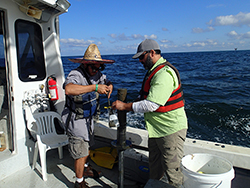Summary: The Gulf-wide offshore sand inventory plan employs a regional ecosystem-based approach to sediment management and directly benefits projects addressing deficits in regional coastal sediment budgets. It also provides information needed to identify and manage use conflicts, ensuring sand resources are available for long term use in coastal management programs.
Background:OCS sediment resources (primarily sand) for barrier island and wetland restoration projects in the Gulf of Mexico have not been evaluated and cataloged on a regional scale. Sand resources in state waters are either diminishing or of poor quality, while excavating sand closer to shore can alter wave climate (the distribution of wave height, period, and direction averaged over a period of time for a particular location), potentially negatively affecting the landward shoreline. Moreover, excavation of nearshore sand often occurs within the active coastal system, compromising long term effectiveness of projects and failing to address the need to supplement the regional coastal sand budget deficit.
Utilizing OCS sand resources minimizes alterations to wave climate and introduces new sand from outside of the active coastal system to decrease the coastal sand deficit, improving project sustainability and geomorphic function.
OCS sand resources in the Gulf of Mexico have traditionally been identified on an as-needed, project-specific basis leading to uncertainty during project planning, conflicts between projects targeting the same resource, and poor long-term management of sand resources. Identifying and delineating sand resources is also important to manage potential use conflicts and ensure the sand is available for the long term.
The Gulf-wide offshore sand inventory employs a regional ecosystem-based approach to offshore sediment management and will directly contribute to other projects addressing the deficit in regional coastal sediment budgets along northern Gulf shorelines. Also, because sediment resources will be mapped regionally, the information will allow for increased options when environmental restrictions may inhibit the use of some potential sediment resources.
This initiative is being conducted through BOEM partnerships with the five Gulf states and other Federal agencies and comprises a programmatic effort to inventory OCS sand resources. The present phase involves coordination with state coastal managers and scientists to conduct a desktop review and synthesis of existing data to identify gaps, develop a strategy for future data collection, and develop a framework for spatial database management and analysis.
In 2016, BOEM entered into 2 cooperative agreements with university partners in Mississippi and Texas which involve new geophysical surveys and geological sampling, data analysis, identification and delineation of sand resources, and spatial database population. The end results will feed into the Marine Minerals Information system (MMIS) which is continually updated with new information as sand resources are utilized or new resources are identified and can be employed by state and federal agency project managers in early planning phases to identify and secure suitable sand resources for restoration projects.
Current Cooperative Agreements:
Mississippi Offshore Sediment Resources Inventory: Late Quaternary Stratigraphic Evolution of the Inner Shelf; Dr. Davin Wallace, Department of Marine Science, University of Southern Mississippi
The overall goal of this study is to provide a better understanding of the geologic evolution of late Quaternary deposits offshore Mississippi and to delineate and develop reserves estimates (volumes) of restoration quality sand resources for discrete sand bodies located on the OCS.
Texas Offshore Sediment Resources Inventory: Development and Application of Geophysical Processing Workflows for Sand Resource Evaluation; Dr. John Goff, The University of Texas at Austin Institute for Geophysics
There are three goals for this study:
- To develop a processing workflow for chirp sub-bottom profiler geophysical data that will improve interpretive capability with applications for sand resource identification;
- To collect new geophysical data to demonstrate application of post-processing techniques developed under Objective 1 and collect geological samples (vibracores) to groundtruth seismic stratigraphic interpretations and improve interpretive capability of the workflow developed under Objective 1; and
- To engage youth by providing a hands-on learning opportunity for students (under direction and with oversight by faculty) to collect, process, and interpret geophysical data, integrate geological and geophysical data for interpretation, and employ the available data to develop evolutionary models of sand bodies offshore Texas and apply the science to quantify and delineate offshore sediment resource reserves.


